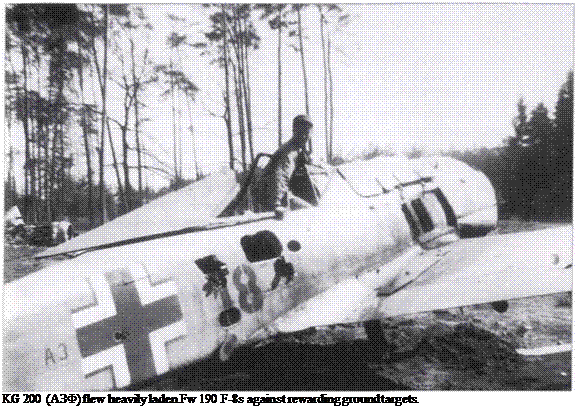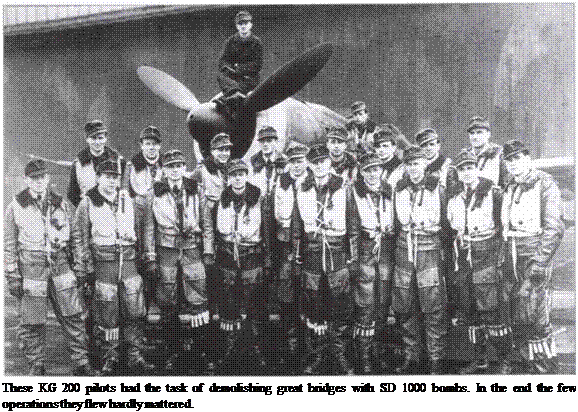Leonidas Staff el, KG 200
The Leonidas Staffel or Kommando Lange, named after the Staffelkapitan of l./KG 200, Oberleutnant Karl-Heinz Lange, was comprised exclusively of volunteers so committed to the cause as to wish to offer their lives unconditionally. In view of the fact that in the long run the Allies could deploy not only more soldiers but more importantly far more fighting machines than the Wehrmacht, Lange had realised that the most effective and accurate weapons possible were required. This meant a manned glider bomb with rudimentary wings descending at a steep angle of 1 in 2 or 1 in 3. The pilot would be seated in a pressure cabin wearing oxygen apparatus. Watching through a small window of armoured glass, he would steer his machine for the objective. The piloted bomb would be brought near to the target by a bomber aircraft flying beyond the range of enemy anti-aircraft batteries.
On 31 July 1943 Oberleutnant Lange had discussed the project with Professor Georgii, leader of Goring s research division, and on 3 September 1943 he had a conversation with Oberst Oskar Dinort, who was fundamentally opposed to suicide operations and had been asked to form the Aerial Target Division. On 27 September 1943 Oberst Dietrich Peltz was reported to have spoken out positively on the ‘total mission and sent a memorandum to that effect to Luftwaffe Command. Three months later Lange was detached to Transport – kolonne ХЗ-Ost but continued to work on his idea. By 25 January 1944 when his proposal had become known to Goring and Generaloberst Lorzer, he had the names of 26 volunteers. At the beginning of February 1944 Lange had a chance to discuss his plan with Hanna Reitsch, and with her help he tried to win Hitler over to the idea of suicide operations.
Generalfeldmarschall Milch and most staff at OKL remained opposed and operations with the manned bomb were prohibited. The KG 200 Kommodore was also against it. However, on 3 February 1944 OKL ordered the formation of a suicide Staffel, for which 120 men had already volunteered. The unit had no motorised aircraft although several Grunau ‘Baby’gliders were available and training went ahead with the Stummelhabicht. On 10 March 1944 Oberst Heinrich Heigl, Kommodore of KG 200, argued that the pilot of a manned, disposable aircraft must be offered at least some small prospect of getting clear before impact.
In mid-February 1944 the volunteers were assessed to select those most suitable for the first operation, and on the 24th Gotha Waggonfabrik received the

contract to build the machines, but the preparations were wiped out by an air raid. Instead of major warships a new target had now begun to interest OKL. Suicide pilots could attack Soviet-held dams and power plants using gliders. Lange informed Heigl of his opposition to the idea on the grounds of the small quantity of explosives which a glider could transport.
The Kommodore had been in favour of using the Fw 190 F-8 with SD 1000s or PC 1400s, and Lange supported him, submitting a memorandum in May 1944 requesting that the children of dead suicide pilots should automatically receive a place at the Adolf Hitler School or one of the National Institutes (Napolas), and also have the opportunity to take part in the Bayreuth Festival or attend the Furtwangler concerts, to mention just a few of the benefits.
After the Normandy landings on 6 June 1944 the military situation in Western Europe had deteriorated rapidly for Germany. When KG 200 was asked six days later if the suicide squad was ready with its Fw 190s, the answer was no because the volunteers had not been trained on motorised aircraft. On 15 June Fw 190 flight training was begun with JG 103 at Stolp and Parow. Fifteen to twenty circuits were to suffice! On 21 June the training was declared concluded
and the pilots returned to Dedelsdorf. Since attacks on the invasion fleet had to be made at dusk or at night, or on a blind approach through cloud, this was too much to ask of poorly trained suicide pilots, and they were now called for bombing training. When the men arrived at Rechlin on 26 June 1944 to practice releasing bombs in a 70-degree dive, they were told that they would have to share one Fw 190 F-8 between them, although a second was expected shortly. Bombing large warships was difficult and, despite the help of Travemiinde test centre only eight to ten bombs came near the target cross.
For the attacks against the south coast of England required by the Luftwaffe planners, 11 Fw 190 F-8s were available on 26 June but the standard of the pilots was poor. At the end of July 1944, however, Hanna Reitsch used Himmler’s office in an attempt to get Hitler to start the ball rolling, but the Fiihrer not only forbade the attacks but the entire piloted-bomb concept. Oberst Heigl was blamed for not having prepared the Fw 190 operation properly.

Apparently, according to Robert Eck, five named members of the suicide Staffel at Rechlin-Larz were to be shown how to fly the manned V-l, and it had even been possible to arrange for five cubic metres of fuel per pupil for the
ramjet. Unfortunately the engines were still not reliable in the late summer of 1944 and the idea had to be postponed.
As the sworn declaration of commitment related to a ‘total mission with the manned bomb as proposed by Oberleutnant Lange, this left the ‘suicidees’ at liberty to refuse any other kind of dangerous mission. Later some of the Leonidas Staffel joined the KG 200 commandos. On 10 January 1945 Oberleutnant Lange was identified as a disruptive influence and transferred to a pilot training school at Braunschweig. The suicide pilots were absorbed into IV./KG 200.
Oberst Siegfried Knemeyer and Oberstleutnant Werner Baumbach both spoke out openly against suicide missions at the beginning of 1945, provoking a controversy with Generalmajor Walter Storp, General der Kampfflieger (Bombers), and the commander of II. Jagdkorps, Generalmajor Dietrich Peltz, who had been put up to it by Goring, and in January the two generals combined to use their influence to help gain acceptance for the kamikaze idea. Through Minister Speer, whom he knew well, Baumbach succeeded in getting Hitler to speak out against the ‘total mission. Leonidas Staffel at KG 200 was disbanded and the men referred to the Luftwaffe Personnel Bureau for new assignments. This brought to an end the efforts inspired by Lange to develop kamikaze tactics. At the end of March the volunteers comprised the SO (Selbstaufopferer-‘smci&z) Groups A and В at 1. Fliegerdivision under Generalmajor Robert Fuchs.










